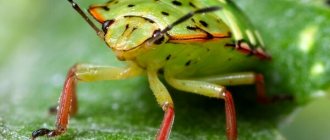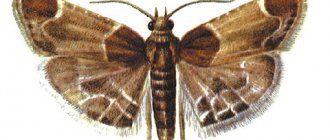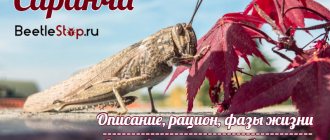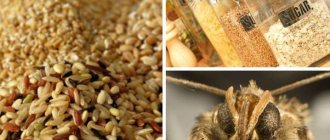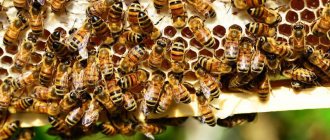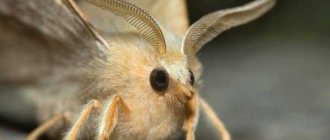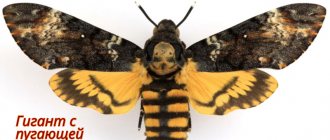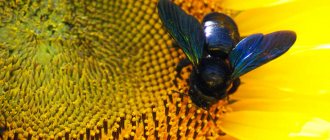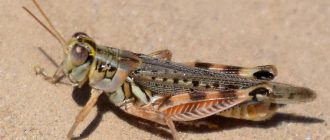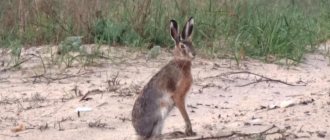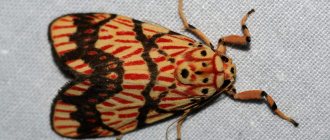- home
- Pest control
- Removing clothes moths in an apartment
- Types of moths
A moth is an insect that absorbs the substance of the stratum corneum - keratin. Such organisms are also called keratophages. But despite this, we often notice these insects crawling in the closet or flying around the house in search of woolen items. Why are they so attracted to wool? The answer is simple: at the molecular level, wool and fur contain the moth's favorite food product - keratin. Thanks to the unique environment of the stomach, which contains a lot of acid, moths easily digest keratin.
general characteristics
The moth belongs to the order of lepidopteran insects that develop their activity at dusk. Adults do not cause any harm. They just reproduce and lay eggs. They do not have a proboscis, since the oral mechanism is equipped with powerful jaws capable of crunching the bones of any plants and feeding on their seeds.
What does a mole look like:
- The pest is very similar in appearance to butterflies.
- But these winged colorful insects feed on the nectar of flowers, having a long proboscis. An adult moth is not even able to digest food. She only breeds offspring. She accumulates all her energy while in the state of a caterpillar.
Therefore, you should not waste energy fighting adult moths: moth larvae feed on things and furniture.
How to get rid of moths in an apartment
There are many options for exterminating lepidopteran pests and disinfecting your home. All methods are divided into two categories:
- Chemical.
- Folk.
The use of special toxic drugs and toxic compounds that are safe for humans, but poisonous for keratophages, allows us to solve the problem radically and in the shortest possible time. Folk remedies involve the use of natural biological substances and a variety of unconventional techniques, tested by generations of housewives.
Destruction of moths with chemicals
Fumigators are popular. These are special electrical appliances that are plugged into an outlet. When heated, they release a toxic gaseous substance that is lethal to flying insects, but harmless to humans. Another common means of combating keratophages is aerosols and sprays. They destroy both adults and larvae.
The drug is sprayed in the room where it is necessary to disinfect. Clothes, furniture, building structures and interior parts are subjected to chemical treatment. The active compound acts instantly and is deadly effective. There are also special traps equipped with adhesive tape. They secrete female pheromones that attract males.
Folk remedies for moth control
The advantages of such methods are:
- high efficiency;
- complete safety for human health;
- wide availability;
- minimal financial costs.
Lepidopteran insects react nervously to the cedar aroma. By placing twigs and pieces of bark of this tree in infected areas, you can get rid of moths in the shortest possible time. Essential oil with a cedar aroma has a similar effect on pests. A simple and accessible way for every housewife to kill moths is to use laundry soap.
They lubricate cabinet shelves, pantry surfaces, and clothes. It is not advisable to use against kitchen varieties of parasites. Products may absorb strong and unpleasant odors. Naphthalene has been known for centuries, but it does not lose its relevance. The substance contains potent carcinogens. Therefore, it is not recommended to use against food keratophages.
Moths are a dangerous pest that causes a lot of trouble for people. Preventive measures and proposed means of exterminating insects will help protect your own home, garden plot, and subsidiary plot. At the first signs of the appearance of a parasite, it is recommended to carry out thorough disinfection in order to avoid the serious consequences of its activity.
Lifespan
Hardly anyone thought about how long a moth lives. She cannot be considered a long-liver. The total lifespan of a winged individual is from 2 to 4 weeks, depending on the type of moth. Insects move and fly little. The main activity occurs at dusk, as they are good prey for any predator.
To reach sexual maturity, the moth must go through certain stages of development:
- the female lays eggs twice a year, from which caterpillars appear two weeks later, the temperature is +20 degrees, which is favorable for the development of offspring;
- Moth larvae form a nutritious cocoon around themselves, where they develop for 3-10 months.
If we consider the full life cycle of an insect, then moth eggs go through a long stage of development to the state of an adult, all this time feeding on the materials and products in which they live.
Major household and agricultural pests
Particular attention should be paid to what the pest moth looks like. There are few of these species, but they can cause significant damage.
Wax moth
Wax moths are a danger to bee hives. The caterpillars of these insects feed on honey and beebread, and also eat bee larvae. In some cases, large colonies can even destroy insulation, which serves as protection for bees from low temperatures.
Interesting fact! The caterpillars of this type of moth are widely used in medicine, since they, feeding on bee products, perfectly digest wax.
Once in the caterpillar's body, the wax breaks down and, combining with an enzyme, forms a unique substance that destroys pathogenic bacteria. This was the reason why wax moth larvae began to be used as a healing agent for many diseases.
Fur moth
When listing the types of moths, it is impossible to ignore the insect that can destroy your favorite fur coat. For this type of insect, your closet, where fur products are stored, becomes a real “paradise”. After all, it is here that she finds an endless source of nutrition.
Fur moth caterpillars carefully trim the fibers using their mouthparts, then crush them and swallow them. After saturation, the larva moves towards its nest and “along the way” cuts off the fur hairs that prevent it from moving freely. That is, these individuals parasitize not only for saturation. As a result, narrow tracks of cut pile are formed on the fur product.
Clothes moth
Clothes moths mainly destroy wool products. External features include the straw color and small size of the insect, which reaches 9 mm with folded wings.
Attention! In addition to items made from natural fabrics, clothes moths can also damage semi-synthetic materials. But with such nutrition, the development process of the caterpillar slows down and it reaches the stage of puberty somewhat later.
Females always move on foot, since, despite the presence of wings, they have no need to fly. During the breeding season, males find them on their own, after which females lay eggs without moving long distances.
Indoor (furniture) moth
The furniture moth is an inconspicuous butterfly of a light yellow hue. Its wings have a characteristic golden tint. Over the course of 15 days, the female lays eggs, the number of which can reach 300 pieces.
While in the caterpillar stage, indoor moths are inactive. They begin to move only after they begin to eat fully. The larvae are very afraid of bright light, and if you put something infected with these pests in the sun, you can see how they begin to hide in folds or crawl into their cocoons.
Important! A decrease in air temperature in the zone of their parasitism can stop the development of caterpillars. They hide in their cocoons and stop parasitizing.
Potato moth
When listing the types of moths, it is worth paying attention to parasites that can cause harm to agricultural land. These individuals include the potato moth. Its appearance is rather unattractive - the wings are a dirty gray color with numerous dark spots.
Fledged individuals have long antennae and live only a few days. When the wings are folded, the body length reaches about 7 mm. The inconspicuous color allows the butterfly to remain invisible even at a short distance when viewed directly.
The caterpillars of this species are distinguished by a light green color; sometimes pale pink larvae are found. The female lays eggs on the underside of the plant leaf, from which, after a short period of time, larvae emerge and begin to develop very quickly.
Attention! The caterpillars die when the temperature drops to +4°C, but having settled directly in the tubers, they can remain alive. As a rule, when cold weather sets in, they move into barns, where they feed on seed potatoes, after which they enter the ground during planting in the spring.
Cabbage moth
Cabbage moth is a pest of cruciferous plants. It has an elongated body and light brown wings. When the wings are folded, the butterfly looks like a small straw. There is a fringe along the edges of the wings of an adult. Like many other species, the cabbage pest flies rather poorly and always remains in close proximity to the place where it emerges from the cocoon.
The caterpillar's head is brown. These insects rarely accumulate in numerous colonies - as a rule, one or two individuals parasitize on one leaf. In the pupal stage, this pest can be found on the stems and leaves of plants, which they feed on.
The eggs of this parasite are easily recognized by their small size and elongated shape. The egg length can reach 0.44 mm, width - 0.26 mm, color - green, which makes them invisible against the background of foliage.
food moth
Food or granary moths can be found in products that were stored in violation of basic rules. Most often these are groceries and cereals. In nature, the source of food for this type of insect is the nuts and fruits of many plants, which causes the parasites to be frequently found in the forest-steppe and steppe zones.
Interesting fact! Food moths are not capable of causing harm to clothing and furniture, since they feed exclusively on cereals, flour, sugar, dried fruits and berries, and can also parasitize in dry pet food.
When the wings of an adult are folded, its body length reaches 8 mm. A moth sitting on any surface is quite difficult to notice at first glance, since it looks more like a small protrusion than an insect.
Caterpillars of this species are light yellow or light pink in color with a smooth body surface. It is impossible to determine the type of barn moth by the appearance of the larvae, but one thing saves you - the fight can be carried out using the same means, so the species is not important.
Normal development of this species occurs under certain conditions:
- air temperature up to +25°C;
- air humidity is about 50%.
The life cycle of a food moth is about one and a half months. This time period includes all stages of insect development.
Chestnut moth
The chestnut moth parasitizes the leaves of horse chestnut and maple trees. They spend the winter in the pupal stage, and with the onset of spring, adult individuals emerge from the fallen leaves, are fertilized, and after 2-3 weeks, offspring appear and adhere to the blossoming leaves.
The parasites leave behind raised orange spots located over the entire surface of the leaf.
Preventing the occurrence of moths is the most powerful argument that will keep your property and garden plot intact and will not force you to throw away food. But if this parasite has already settled near you, then you must immediately choose an effective remedy to combat it.
The modern market is replete with a variety of insecticides for these pests, but it is worth remembering that some species are able to quickly develop immunity and continue to reproduce intensively.
Varieties
Types of moths
There are about 3,000 representatives of these insects, and only a few dozen of their varieties are pests. They don't differ much in size. The main differences are in color, habitat, body and wing configuration. The following types of moths are best known to man:
- household: clothing, food, furniture, fur coats, carpet, wool;
- in the wild: ermine, foxglove, chestnut;
- in agriculture: cabbage, potato, wax, fruit, grain.
Interesting!
In nature, the life of a moth depends on weather conditions and the time of year. The man offered her more comfortable living conditions: constant warmth and food in abundance. Therefore, everyone knows from their own experience in dealing with this scourge how moths multiply in human habitation. It reproduces all year round, and the caterpillars of these apartment lovers go through all stages of development faster than their counterparts living in natural conditions.
Moths can get into an apartment in a variety of ways. Food or potato representatives most often enter the home through food products that are stored in warehouses for a long time. They lay eggs directly in the packages. The wood pest enters through ventilation ducts.
Methods of disposal
If there are moths in your apartment, there are several ways to get rid of them:
- Special aerosol. This remedy will help if you find the place where it lives and treat it. After using the aerosol, you need to leave the house for several hours, and after returning, do a wet cleaning.
- Velcro or moth traps. They are hung in the kitchen or near cabinets, the moth sticks and dies. Often they are simple paper, with a sticky backing, and are attached to inconspicuous areas of the cabinet.
- Pills . They can be placed in areas where moths are likely to appear.
- Folk remedies . This includes various repellent compositions of herbs, washing with soap or vinegar.
- To combat agricultural moths, indoor treatments are carried out; infected grain is heated or frozen. The room must be disinfected and dried well.
What are the best anti-moth products?
ChemicalFolk
Vegetables in which moths have infested are also treated. You can use chemicals or traditional methods that last longer and are more effective.
Any moth does not like strong movements and temperature fluctuations. Therefore, temperature treatment helps at home. Moreover, it tolerates both frost and heat equally poorly.
Clothes moth
Clothes moth
It is a small straw-colored insect up to 9 mm in size. This pest cannot appear just like that. He gets into the house with things that are bought in the store. The larvae are already hiding in clothes or furniture. After getting into the apartment, they simply begin to develop intensively and expand their habitats, settling on other wardrobe items in the clothing closet. The larvae especially love products made from natural materials, wool, and fur.
In several other ways, clothes moths can appear in the house:
- through open vents and windows;
- ventilation communications;
- from neighboring apartments.
In order not to breed malicious tenants in your apartment, it is necessary to install nets on window openings and ventilation vents.
Important!
Clothes moths can destroy not only old, but also new clothes. Worn items and second-hand furniture are more attractive to this species, as they make the path to the food source easier.
To prevent clothes moths from infesting your home, you must carefully inspect all seams, fur items, and shoes purchased at retail outlets. How to get rid of clothes moths if flying butterflies do appear:
- It is necessary to spray the products with special aerosols, wash them in hot water or treat them with steam.
- You can take things out into the sun and fry them for several hours.
- After processing, store in special tightly closed duffel bags.
What do moth larvae eat?
The consequences of the life activity of the house moth larvae look like a mixture of gnawed fabric, fur or dry foods mixed with a dusty substance.
Wool, fur, clothing and furniture insects feed on natural or mixed fibers, including some types of synthetics. The fur moth is capable of laying a path along its route, which will look like a shorn strip.
Moth eats fur coat
A smaller variety of furniture parasites immediately selects upholstery areas with a large amount of material for laying eggs, so that the hatched individual is provided with food from the moment of birth and cannot die. A hole appears in the place where furniture moths live.
Feeding individuals destroy the structure of grains and cereals, turning them into dusty mush, held together by the biological material of caterpillars and eggs.
Moth eats cereal
Wool moth
This species is quite widespread. It lives not only in apartments and warehouses, it can be found in mills and museums. The larvae eat dirty clothes and dust. Therefore, you can hear the name dust moth. The larva is not able to completely eat clothing, but spoiling it well is not a problem. The wings can have a span of up to 2 mm. The front ones are painted light brown, with a golden-pearl tint. The hind wings are distinguished by a beige color, and there is a fringe along their edges.
On a note!
This species is very prolific; the female is able to lay up to 90 eggs during her very short life.
Special means
Case for fur coats
Special cases for storing fur coats and coats are available for sale. They are impregnated with insecticides from the inside and smell of lavender and lime to repel butterflies. In such a case, the product will definitely remain safe and sound. A protective cover to prevent moths from starting to eat your fur coat, suggests Raptor. Price 389 rub. The shelf life is 36 months.
If the cost of a special cover is not satisfactory, and the question of how to treat a fur coat against moths remains open, you can use moth repellents in the apartment: aerosol Raptor, Armol, Clean House, or any spray with a broad spectrum of action and a pleasant smell. The same remedy is used if there are moths in a fur coat. The product is taken out into the fresh air, hung, treated with an aerosol, and left to dry. Place in a plastic bag for storage. The price of an aerosol is within 250 rubles.
Moth repellents for fur coats are available in the form of sections, tablets in a plastic base, pendants, and stickers. All of them have a repellent property and create unfavorable conditions for egg laying.
On a note!
Most of all, moths are afraid of the smell of lavender and citrus fruits, which is why fumigators smell like that. Essential oils are added to the composition, the action lasts from 1 to 6 months. The products are laid out in the closet and glued in a convenient place.
Furniture moth
This type of moth is light yellow in color with golden wings. The female lays up to 300 eggs within a half-month. The larvae begin to move actively only when they gain access to adequate nutrition. The moth lays its eggs in crevices of wood, under furniture upholstery, eating it. Every homeowner dreams of getting rid of moths in their apartment. Indoor moths are afraid of sunlight, so the larvae begin to hide in cocoons. Unfavorable conditions prevent caterpillars from developing and parasitizing.
Furniture moths are similar in appearance to a food pest; it is quite difficult to distinguish them. If you look at a photo of a moth, only a specialist can recognize whether this individual eats wool or cereals.
Appearance of a moth larva
Everyone can imagine a small fruit worm, which is often found in apples or other fruits that have not been treated with pesticides. This will allow you to understand what a moth larva looks like.
Appearance of a moth larva
The pest caterpillar is pale yellow in color, has 12 limbs and a darker head. The length can be from 6 to 12 mm. Thickness no more than 2 mm.
Fruit caterpillars and moth larvae are similar in appearance, so the presence of pests in the house is easier to notice by flying silvery moths.
food moth
Food moth
Larvae of this species prefer to feed on grocery products, so they will not touch wool or fur. They are omnivorous for foods that contain carbohydrates. The most popular characteristics for larvae are:
- flour;
- cereal;
- seeds;
- pasta;
- cookie;
- dried fruits;
- nuts;
- candies.
Their presence can be detected by molded lumps of cereal and cobwebs on the grains. If tunnels are made in pasta, then this is a sure sign of the presence of parasites. Food moth larvae can be found wherever there is free access to food.
Important!
Moth caterpillars can even cope with plastic bags, so it is better to store food in metal, glass or wooden packaging.
The reproduction and development of the larvae of this species is faster than that of the clothes one, since the food of food representatives of insects is more varied and nutritious. If you find larvae in food, you need to throw them away immediately and try to get rid of food moths in the kitchen as quickly as possible. If the contamination is small, then the grains can be sorted, the flour sifted and everything calcined in the oven at a temperature above +50 degrees.
What to do if a moth still eats a fur coat
When a moth has eaten a mink coat, the owner is not always able to save the product. This is influenced by the degree and area of the damaged area (which fragment of the fur coat was eaten by the moth). If there are too many “bald patches”, then you will have to say goodbye to the fur coat or you will need to change the style of the product, shorten the bottom or cut off the sleeves.
If a fur coat is eaten by moths, but the damage turns out to be insignificant, then the defect can be eliminated with the help of paint. The result depends on the correctly selected paint tone . Sometimes the bald spot is cut out and the edges are carefully sewn together from the inside. If the stain is on the chest or collar, then it can be covered with a brooch or scarf.
Wax moth
This insect is a threat to beekeepers. When settling in hives, caterpillars eat honey, bee bread and bee larvae. If there are a lot of pests, they can damage the protective layer of the hives, which prevents the bees from freezing in the cold.
Interesting!
Man has learned to use moth caterpillars for his own purposes. Since fermentation in the moth's stomach produces a substance called wax moth extract, which can destroy pathogenic bacteria, people have begun to use it as a natural remedy to treat many diseases. The extract-based preparation is known as wax moth tincture.
Preventive actions
There are simple rules on how to protect a fur coat from moths.
- After the cold weather is over, you should take the product to the dry cleaner to eliminate the smell of sweat.
- Clean out the closet. Remove all items and wash the cabinet with water and vinegar or lavender essential oil. Clothes that will not be worn until cold weather need to be washed, dried, and packaged in plastic bags. Fold the clothes. Lastly, hang up the fur coat.
- The fur product must also be packed in a plastic bag. There are special cases for storing fur coats on sale.
- If moths or moth larvae are found in the closet while cleaning, you should use insecticides. Treat the moths, then proceed with wet cleaning.
- You should periodically leave the cabinet door open for ventilation.
- It is recommended to take the fur coat outside into the scorching sun at least twice during the storage season.
- Before placing the fur coat in the cover, you can initially spray it from the inside with an insecticidal agent. Air it so that the smell disappears, then put it on a fur product.
Potato and cabbage moth
These pests can destroy crops. Their difference lies not only in color, but also in the type of food that they prefer. Dirty gray moth, settling in potato tubers, damages the integrity of the fruit, and in the spring, during sowing, it again enters the soil.
The cabbage representative looks like a straw when its wings are folded. It flies poorly, but multiplies quickly, damaging the juicy young leaves of the vegetable. As a result of such proximity, the cabbage crop may die.
Why are moth larvae dangerous?
The greatest health hazard is foodborne pests. In a few weeks, they can settle in almost all grocery products and not only digest some of them, but also contaminate them with waste products.
The use of contaminated mixtures can lead to intoxication of the body.
The risk of illness when wearing things after clothing moths have lived in them without cleaning occurs primarily in people suffering from allergies. After using the fabric, the wearer's skin may become irritated.
Popular questions
When housewives purchase an expensive fur product, they may have various questions about fur moths.:
- How to detect moth eggs in a fur coat? It is almost impossible to detect them. Moth eggs are so small that they are difficult to see with the naked eye. They do not exceed 0.5 mm in length. They are usually white in color and oval in shape. Under favorable conditions, larvae appear within 7 days.
- What are the signs of a moth infestation? Since the larvae cut out grooves, folds or wrinkles appear on the product. The larvae also shear off the fur, which leads to the formation of bald patches. In addition, moths are actively fluttering around the room.
- Where else can you find fur moths? Its caterpillars can be found in horseradish, cayenne pepper, saffron, bay leaves, mustard seeds, orris, opium poppy fruits, almonds, and peanut husks. In addition, this parasite can damage stuffed animals, unique zoological objects, tobacco stocks, as well as raw sheep wool.
The appearance of fur moths is a big nuisance that can be avoided if you follow reasonable recommendations during storage. It is always easier to prevent the appearance of such insects in the closet than to later deal with the consequences of their vital activity.
